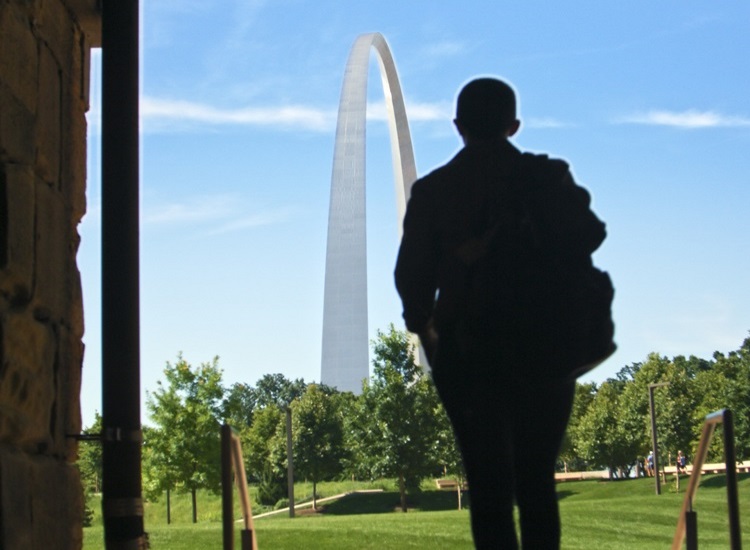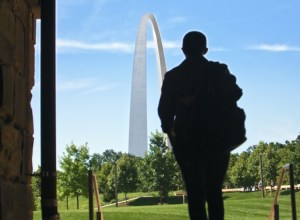Attending a University in the Midwest

Postsecondary education doesn’t just happen in the classroom. It’s an experience: sunny afternoons reading literature on the campus lawn, brisk evenings cheering along with fellow sports fanatics, and weekends spent with new friends exploring the local scenery. Or perhaps it’s diving into a challenging, engaging, and spirited debate with your classmates and your professor, developing the communications skills and knowledge you’ll need as a working professional — all done from your local coffee shop or living room, thanks to innovative online education opportunities.
The right mix of cultural and social experiences alongside nationally recognized, specialized programs may be found in the U.S. heartland. Aspiring students searching for the right program should consider attending a university in the Midwest.
What Is the Midwest?
The Midwest, known as the American heartland, is a region comprising Illinois, Indiana, Iowa, Kansas, Michigan, Minnesota, Missouri, Nebraska, North Dakota, Ohio, South Dakota, and Wisconsin.
The region is one of the most ecologically diverse in the country. Expansive farmland cultivating corn and soybeans fills the area known as the Great Plains, which stretches from the Rio Grande in Texas and follows the Rocky Mountains into southern Canada. Rolling farmland is broken up by the Black Hills, home to the famous Mount Rushmore, and the majestic Ozark Mountains. And there’s plenty of water to go along with the plains and hills, from the Great Lakes to the thousands of smaller lakes found throughout the region. However, the Midwest boasts more than beautiful landscapes.

Reasons to Attend a Midwest University
Prospective students have over 1,000 postsecondary institutions with both two- and four-year programs to choose from in the Midwest, according to Statista. Selecting the best Midwest college often comes down to the characteristics of the institution, surrounding cultural attractions, and affordability.
High-Quality Universities
Schools in the Midwest run the gamut from small, private colleges to large public universities. Of the 650 top schools listed in Forbes’s “America’s Top Colleges 2019,” close to 25% were located in the Midwest. While the larger universities tend to draw the most attention — especially during football season — smaller schools such as Maryville University provide high value, opportunities and experiences that benefit students during their college years and beyond.
Midwest Cultural Attractions
The Midwest has spectacular landscapes, including seven national parks. Badlands National Park in South Dakota is a striking contrast to its surroundings, with unique rock formations that rise from the prairie.
Visitors can escape the dry heat of South Dakota by traveling east to the more humid climate of the Great Lakes. Tourists can explore Lake Superior via a three-hour ferry ride from Copper Harbor, hopping off to hike through the Michigan backcountry. And if you have a surfboard, bring it: there’s a small but dedicated group of surfers who ride the waves of Lake Michigan.
While the Midwest is known for a relaxed lifestyle, excitement can be found around every corner. Adrenaline seekers can take in the Indianapolis 500 at the Indianapolis Motor Speedway every May or experience the thrill of professional sports, such as the NHL’s St. Louis Blues and the NFL’s Green Bay Packers.
The Midwest is full of rich history and culture. After the Civil War in 1865, the Midwest experienced an economic boom as trade routes opened the door for industry and immigration. Cities like Chicago quickly grew as people moved west to find new opportunities. Today, cultural attractions, such as the Museum of Science and Industry, the Art Institute of Chicago, and the Henry Ford Museum, celebrate the industrial spirit of the Midwest.
Regional Affordability
Living in and exploring the region is possible on a modest student budget: The region has a lower cost of living than the rest of the country. GoBankingRates recently reported that when compared with the rest of the country, Midwestern residents pay $3,098 less in rent and $4,454 less in mortgages each year; pay less in transportation costs each year: $9,548 versus the national average of $9,576; and pay less for groceries each year: $4,100 versus the national average of $4,363.
Reasons to Attend a University in Missouri
Missouri has 115 of the 1,031 colleges in the Midwest. The state has a range of public and private institutions for every student, from private, Christian liberal arts undergraduate schools to public research universities.
Many of these institutions are in the cultural epicenters of the region. St. Louis is full of artistic expression, with the glimmering Gateway Arch overlooking the city and Citygarden showcasing beautiful interactive sculptures. Springfield, the birthplace of the historic Route 66, has recently become a top destination for food lovers in the Midwest. The Power and Light District in Kansas City is an exciting area of downtown that hosts more than 150 free events and concerts each year and transforms into celebration central when the Kansas City Chiefs or Royals win.
The forest-covered Ozarks are a great destination for outdoor enthusiasts. Tourists can explore underground streams and caves or summit Taum Sauk Mountain, the tallest peak of the Ozarks.
Maryville University: One of The Fastest-Growing Universities in the Midwest
Stretching across 300 acres on the outskirts of St. Louis, Maryville University is a perfect location for prospective students looking for a unique blend of quiet Midwestern life that’s just minutes away from cultural and entertainment hot spots. It’s not just the location that draws students to Maryville. Maryville University has a nearly 150-year history of academic excellence, and is building on that history through an innovative approach to education. Indeed, Maryville’s tech-forward educational leadership earned the school recognition from Apple as an Apple Distinguished School for 2021-2024. Maryville was also named the “Fourth-Fastest Growing Private University” by The Chronicle of Higher Education in its 2021 edition of the annual Almanac of Higher Education.
Maryville University’s student population is expected to reach over 10,000 students in the 2019-2020 academic year, an increase of 10 percent from the start of classes last year. This marks 15 years of consecutive enrollment growth for Maryville. The expansion of Maryville’s online degree portfolio is helping to fuel this growth, and illustrates the university’s student-centered approach, which aims to meet the higher education needs of all adult learners, regardless of location, age or circumstance.
Unique History
Founded in 1872, Maryville started as an academy for young women and underprivileged youth, a progressive idea for the time. Maryville quickly expanded in the 1920s, evolving into a junior college and awarding its first bachelor’s degrees. In the 1960s, a new campus was opened and male students were admitted to the institution.
Maryville became Maryville University of St. Louis in 1990, keeping its original progressive mindset and creating the College of Arts and Sciences, the School of Business, the School of Education, and the School of Health Professions.
Diverse Programming
Today, Maryville University offers over 90 programs for undergraduate, master’s, and doctorate students in both on-campus and online settings. The nursing and business schools have many popular programs, in part due to the focus they place on student career outcomes and the skills needed to excel in modern industries. By applying a real-world emphasis on the curriculum, Maryville helps students develop both a strong subject knowledge base and a set of practical skills that they’ll be able to leverage in an increasingly competitive job market.
For those who are taking the brave step of furthering their education, Maryville offers abundant opportunities for postgraduate students looking to build their skills and expertise and take the next steps in their careers. The online Master of Business Administration (MBA) program offers a variety of concentrations, such as Business Data Analytics and Strategic Communication and Leadership.
Experienced Faculty
In all Maryville programs, students learn from and work with experienced faculty members who prioritize learning for the real world. With an average of 20 students per class, students benefit from professors willing to develop meaningful mentoring relationships.
“Maryville is just a really amazing place in the respect that the people who taught me — the professors I had in the semesters I was here as a student — just really knew how to care,” Geralyn Frandsen, assistant director and professor of nursing, says. “They really knew how to spark your knowledge, your enthusiasm for education. And that’s what I wanted to continue to do throughout my career.”
For students studying online or away from campus, Susan Bartel, assistant director of the higher education leadership doctoral program and associate professor of higher education leadership at Maryville, says she thinks about students first: “I really try to think about what it is like to be a student in one of our courses sitting 3,000 miles away — or further if they are international — and how I can draw them in to what the community of learners really means and what it is so they can walk away from the course not only with information, but really feeling connected to the students, the faculty, and ultimately, the university.”
High Job Placement Rates
For Dustin York, associate professor of communication at Maryville, taking a student-centered approach and applying classroom skills to professional settings is a big part of the school’s and students’ success. This approach has helped many Maryville students successfully land jobs by the time they graduate: the online undergraduate program positive career outcome rate is 96 percent.
“My key performance indicator is [whether we’re] setting up our students for career and professional community success for our program. And the data confirms that we are,” says York.
Maryville University Could Be the Perfect Fit
The American heartland is more than a region; it pulses with energy and culture, creating unique experiences for today’s students that they’ll carry into the future. Aspiring students of all ages may find Maryville to be their Midwest university of choice. Alongside its residential programs, Maryville offers distinct, flexible online degrees, such as the Bachelor of Fine Arts in Digital Media and the Bachelor of Science in Sport Business Management. These options are ideal for students who want to be a part of the Maryville community, but may not be able to accommodate a residential program.
Learn more about Maryville’s programs and how to apply by visiting the Maryville University Admissions page and start your Midwest education experience today.
Sources
Forbes, “America’s Top Colleges 2019”
Forbes, “25 Top Colleges in the Midwest 2019”
Forbes, “Regional Differences in Higher Education: Where Is the Best Place to Go to College?”
GoBankingRates, “How Much You Could Save by Moving to the Midwest”
Lonely Planet, The Great Plains
Maryville University, About Maryville
Maryville University Admissions
Maryville University, Dustin York
Maryville University, Geralyn Frandsen
Maryville University, Maryville University Announces Expansion of Online Degree Programs
Maryville University, Maryville University Projects Record Enrollment in 2019-2020
Midwest Living, “20 Top Things to Do in Missouri”
Midwest Living, “50 Midwest Museums We Love”
Midwest Living, “The Greatest Midwest Food Towns”
Midwest Living, “The Ultimate Midwest Bucket List”
National Park Service, Badlands
National Park Service, Indiana Dunes
National Parks Tours, National Parks of the Midwest
Springfield, Springfield History
ThoughtCo, Maryville University of Saint Louis Admissions
ThoughtCo, Top Missouri Colleges
U.S. News & World Report, Overview of University of Illinois — Urbana-Champaign

